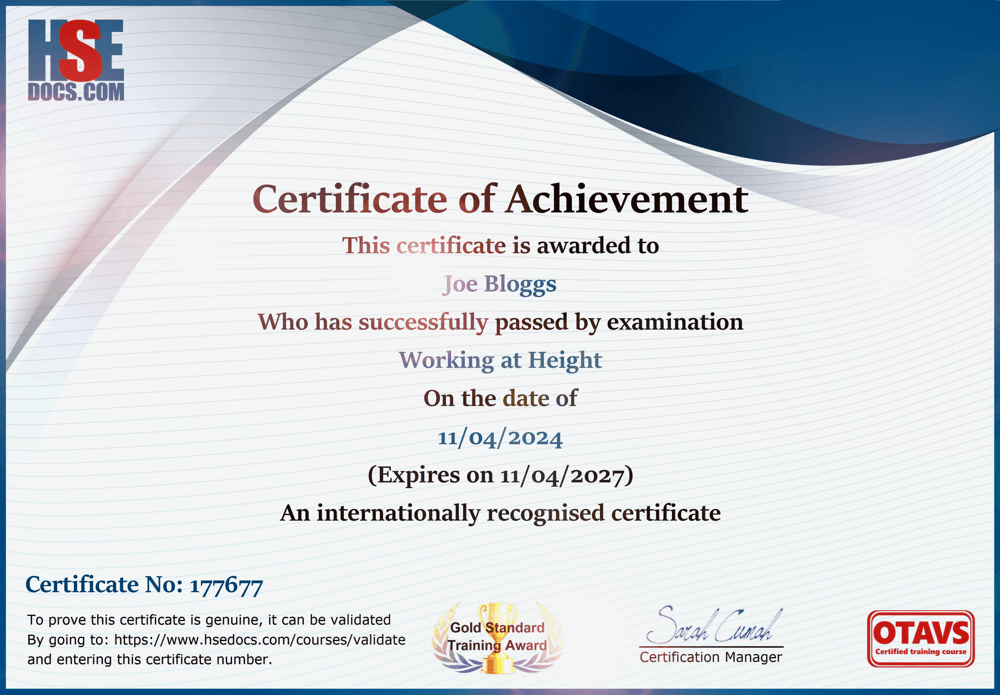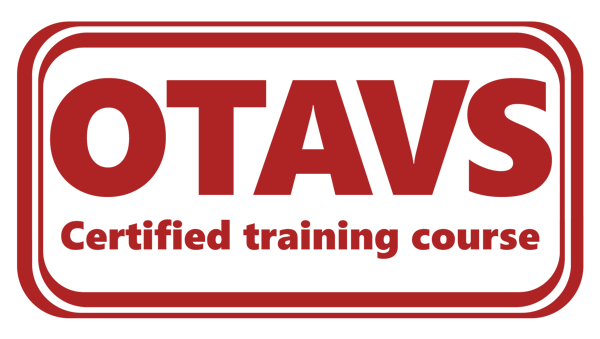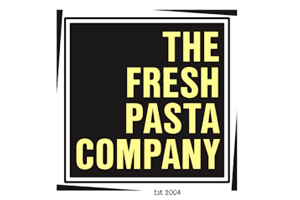Online Food Allergen Course for Cafés and Restaurants
Covering food allergens and Natashas Law
Course certificate valid for 3 years
Internationally accredited training
HSEDocs provides this Level 2 Food Allergen Training Course for food retailers with an internationally recognised certificate for individuals responsible for handling and preparing food. This comprehensive course covers all essential topics related to food allergens, guaranteeing that you acquire the necessary knowledge and skills to handle food safely and responsibly. Upon finishing the course, you will receive a certificate of competency in level 2 food allergen safety standards.
£9.99 for an individual course, £6.49 if you buy 10 or more, and just £4.99 for bulk orders of 50 or over.
This course is accredited and certified by OTAVS.
Online Training Accreditation & Verification Service
Course duration: Between 1 ½ and 2 ½ hrs depending on learning speed.
Course format: Three video training modules, with a multiple-choice section at the end of each module.
Entry Requirements: Anyone can complete this course, whether they have previous experience or not.
If you work in a factory or manufacturing unit, cafe, or from home producing packaged products that are to be sold at another location, then this online Level 2 Food Allergen course is for you.
After completing your online Food Allergen course, your training certificate will be valid for three years. It is internationally recognised and counts towards your Food Hygiene Rating.
All successful candidates are entered on the national training register, and certificates can be verified by employers or others to prove that they are genuine by clicking Validate a Certificate and typing in the certificate number.
Overview of HSEDocs Level 2 Food Allergen Course
Our Level 2 Food Allergen course follows the current national curriculum.
The learning topics covered in this course include:
- What are allergens?
- Types of allergic reactions from allergens and foodstuffs.
- Symptoms of allergic reactions from allergens and foodstuffs.
- Using an auto-adrenalin-injector.
- The Food Information Regulations 2014.
- The fourteen listed allergens.
- Correct product labelling.
- Precautionary warnings.
- Natashas law.
- Training and allergen management.
- Stock and storage.
- Cleaning
- Personal hygiene.
Learning about food allergens is essential to protecting customers from products that could potentially cause them harm, even though most people consider the product safe. The need for allergen training and correct allergen labelling of foods was highlighted by the devastating tragedy bestowed on the Ednan-Laperouse family, which brought about Natashas Law.

Natasha's Law was enacted after the tragic incident involving Natasha Ednan-Laperouse, a teenager who suffered a fatal allergic reaction in 2016 after consuming a pre-packed sandwich. The packaging did not provide clear allergen information, which led to Natasha unknowingly ingesting sesame seeds, to which she was severely allergic. This event highlighted significant shortcomings in food labelling regulations and sparked a call for legislative reform.
Natasha's parents, along with various advocacy groups, advocated for stricter labelling requirements to prevent similar tragedies. Their efforts brought considerable attention to the issue of allergen transparency in pre-packed foods. The campaign gained momentum and ultimately led to the development and enactment of Natasha's Law.
This legislation was designed to address the gaps in the existing labelling system, ensuring consumers can access crucial information about potential allergens in their food. The aim was to empower individuals with allergies to make safer choices and reduce the risk of accidental exposure. The government's decision to implement Natasha's Law reflects a commitment to enhancing public health and food safety standards.
This significant change mandates that all pre-packed foods, including those made and sold on-site, must list their ingredients, emphasising allergens. It represents a collaborative effort between policymakers, consumer rights groups, and affected families to create a more transparent and accountable food industry.
Natasha's Law poignantly reminds us of the real-life consequences of inadequate food labeling and the importance of proactive measures to protect public health. The introduction of this law marks a significant step towards better-safeguarding individuals with food allergies, aiming to prevent further tragedies and improve overall food safety practices.
Establishing a safe kitchen environment is essential for effectively preventing allergen contamination. Here are several strategies we teach to improve allergen management practices:
1. Distinguish Between Allergen and Non-Allergen Foods: Implement a system of colour coding for tools, utensils, and storage containers. For instance, use blue for allergen-free items and red for those containing allergens. This visual differentiation significantly reduces the risk of accidental cross-contamination, making it easier for kitchen staff to identify and handle foods safely.
2. Use Dedicated Equipment: Invest in specific cutting boards, knives, pots, and pans exclusively for allergen-free cooking. Clearly label these items with prominent tags or engravings to prevent any mix-ups during food preparation. Consider using materials that are easier to clean and sanitise, such as stainless steel or plastic, designed explicitly for allergen-free cooking.
3. Store Allergen-Free Foods Safely: Use airtight and transparent containers for allergen-free foods, clearly marking them as such. This protects these items from exposure to potential allergens and allows for quick identification. Designate a separate area in the pantry or refrigerator for allergen-free items to minimise the chance of contamination from other foods.
4. Organise Storage Areas: Arrange your storage areas methodically, store allergenic ingredients on upper shelves or designated bins, and place allergen-free ingredients on lower shelves within easy reach. This physical separation reduces the risk of airborne allergens or accidental spills contaminating your allergen-free products.
5. Label Everything Clearly: Ensure that all containers, including those holding both allergenic and allergen-free foods, are clearly labelled with detailed information about their contents. Use bold text and clear symbols to indicate potential allergens.
6. Create a Dedicated Food Preparation Area: If space permits, establish a dedicated section within your kitchen for allergen-free cooking. This should be equipped with utensils, tools, and appliances, thereby minimising the risk of cross-contact with allergens. Ensure that this area is thoroughly cleaned and sanitised before food preparation begins.
7. Train Your Staff: Provide comprehensive allergen safety training for all kitchen staff. This training should encompass awareness of common allergens, understanding of cross-contamination, proper food handling techniques, and emergency procedures for allergen exposure. Conduct regular refresher courses to update staff on best practices and new regulations.
Each day, restaurants serve many guests, offering memorable dining experiences. However, individuals with food allergies may experience anxiety and concern, as well as face significant health risks when dining out. This highlights the need for allergen awareness and training. Without adequate training, staff may be unable to communicate confidently about allergens or advise customers on which foods to avoid, thereby compromising the dining experience, diminishing customer confidence in the establishment, and maintaining substantial risks. Conversely, equipping staff with appropriate knowledge and skills safeguards customers, creating trust which enhances the dining experience and distinguishes a restaurant as a responsible and inclusive establishment.
For individuals with food allergies, even a minor mistake—such as accidental cross-contamination in the kitchen or an uninformed server providing incorrect ingredient information—can trigger severe allergic reactions. These reactions can range from hives to anaphylaxis, potentially resulting in hospitalisation or, in the most tragic cases, fatalities.

Contact Our Food Health & Safety Experts
We are always happy to help here at HSEDocs, so if you have any questions about allergen training, please give us a call.

 CART
CART 














